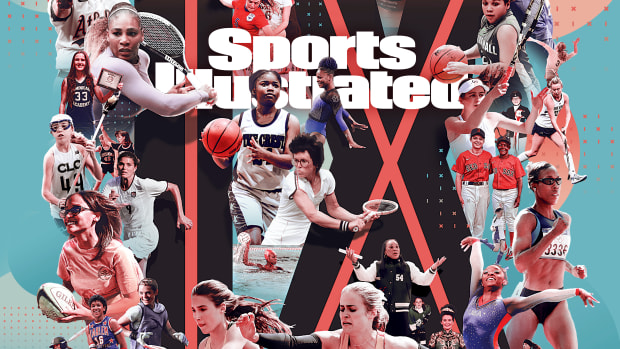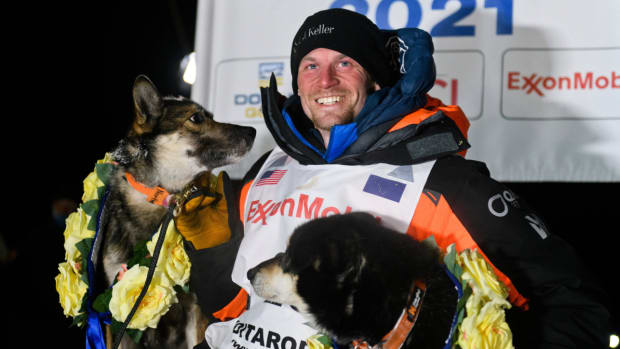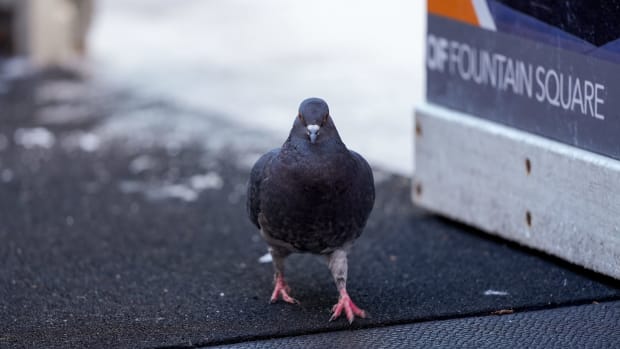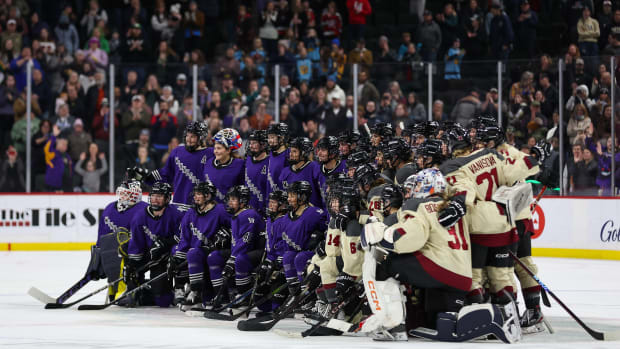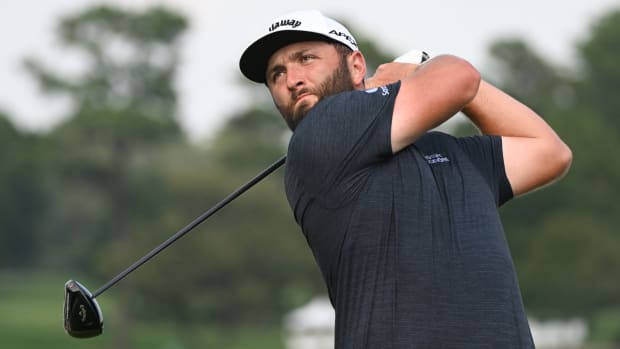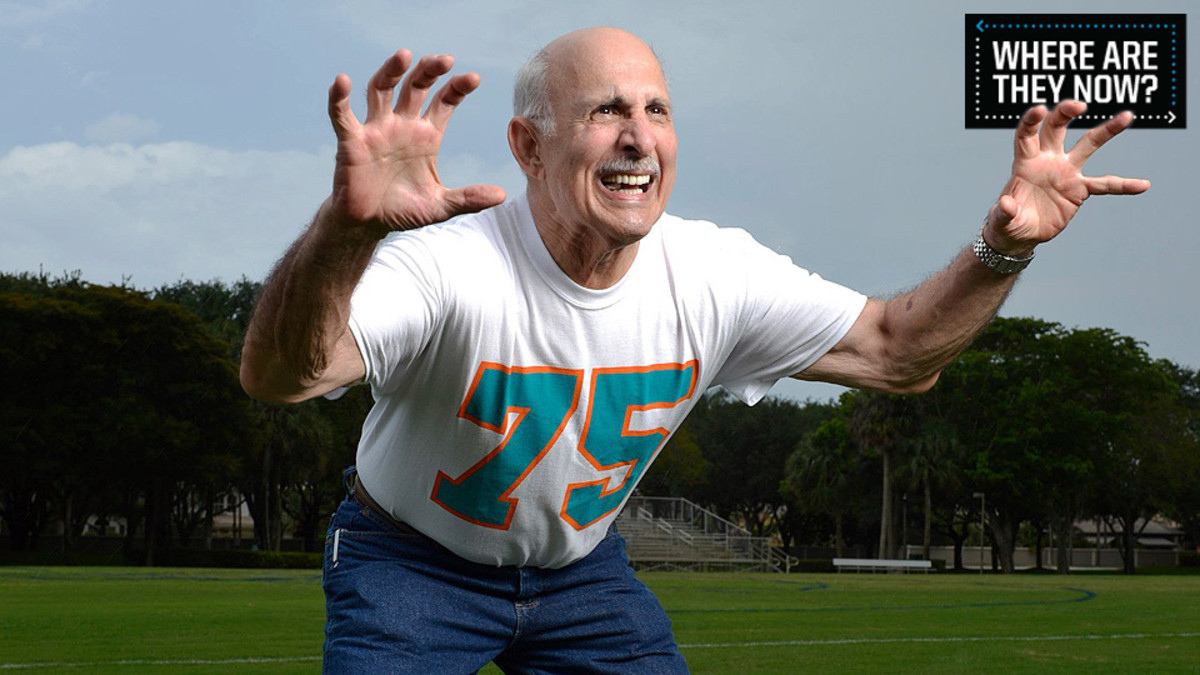
Chairmen of the Cardboard: Recreating memorable trading cards
They're hardly a Hall of Fame crew; they rarely even get recognized at Starbucks. But slap a sombrero on one of them, hand him a saxophone or a novelty-sized glove, and —Hey! I know that guy. They're the players—mostly journeymen (39 combined stops) and utilitymen (35 positions)—whose faces you remember from collectible cards, their backs stained with bubble-gum sugar. And they want you to know that they appreciate your love.
Illustrations by Allen Kim
Manny Fernandez, 1976 - Topps
Eight seasons on Dolphins’ D-line; two-time Super Bowl champ. Now 68, he lives on 80 acres of land in Ellaville, Ga.; loves to hunt—and “that’s pretty much it.”
[Drag the white bar from side-to-side to see the original and updated card.]
Mr. Big Shot:“I have very little recollection of [that photo shoot] at all. They did one every summer; it was just another photoshoot to me. I think they told me what to do; I didn’t come up with that pose. We were doing two-a-day practices in 100-degree heat and I just wanted to get back in the AC.”
It's in the Cards: “I get cards every single day in the mail to be autographed. They send me all sorts of different cards, but this one’s in their a lot. Sometimes they send cards that I’m not even on. I got one the other day of [Raiders receiver] Mervyn Fernandez. That was probably a little bit of a mishap.”
[pagebreak]
Eugene Robinson, 1991 - Pro Line
Three-time Pro Bowler at safety over 16 seasons with four teams; won Super Bowl XXXI with Packers and picked off 57 career passes (No. 13 all-time in NFL). Now 52, he coaches highs school football, wrestling, and track in Charlotte.
Mr. Big Shot: “This was around when the craze for Zubaz pants just started, and Zubaz wanted to get in the trading card game. They wanted to show athletes in their natural environment. I told them I played saxophone and they said, ‘That’s great; bring your sax.’ During the shoot I just messed around, maybe played some blues scales. It was a conscious decision to not have shoes on. It was a laid back style, so I had my Zubaz pants, my sax, no shoes—and of course the shirt to show off the abs. That was just me trying to get my sexy on.
It's in the Cards: “Don’t forget: Zubaz in 1991 was a hot commodity. And these were not like regular football cards, not action shots. You got to see my face, behind the scenes, and I’m chilling. People loved [the cards]. They thought it was really fun and jazzy and exciting. Now, though, most people don’t think those pants are too cool anymore. When [my students] see the photo they say, Coach Rob, Come on. Look at you, this is kind of corny. That or: Look at you, coach—you actually had hair!”
[pagebreak]
Brian Harper, 1993 - Upper Deck
Sixteen seasons at catcher with seven teams; won ‘91 World Series with Twins. Now the hitting coach for the Cubs’ Triple A affiliate, in Des Moines, and an avid runner—he’s completed three half marathons.
Mr. Big Shot: “When we were on the road we had a 5 o’clock stretch, 5:15 BP—but we’d get [on the field] at like 4:30 and just sit around. A guy came up to me and asked, ‘Would you do a radio interview?’ So he brings me this huge cell phone. There were always a couple baseball photographers around; I saw one, and I’m thinking, Oh, great. I guess the photographer decided that was the photo he wanted because that was my card the following season. When I saw it I was like, Come on, really? Of all the pictures they could have taken— me hitting a line drive or catching the ball. . . .
It's in the Cards: “Our hitting coordiator usually hangs up pictures of all the coaches—and of course that was the picture he chose for me. He had it blown up. And the kids that I coach bring up that card pretty much every year, like I was actually carrying that cell phone around with me on the field. They assume it was my phone and I was just making a phone call. . . . I have to tell them I wasn’t carrying it around in my pocket. That was the original iPhone right there.”
[pagebreak]
Kurt Rambis, 1990 - Skybox
Played 14 seasons, most notably nine for the Lakers, with whom he won eight titles—four as a power forward, four as a coach-exec. Now, at 57, an assistant with the Knicks.
Mr. Big Shot: “I don’t know if I stood out with those short shorts, or if everyone was still wearing them—but I think people related to the intensity and the work ethic you get out of that photo. These days, they beg me not to suit up at [Knicks] practices—I might get suspended for a flagrant foul. Adam Silver might call. . . . I’m losing my hair now; I wish I still had that long hair. And the black glasses in the photo—those are the only ones anyone remembers me for, because that’s what they saw me wearing on television, but I only wore those when I played. I had a multitude of styles that I wore off the court. I still wear the glasses sometimes, but I had LASIK surgery several years ago, so the prescription is far less intense now. When I was playing and the glasses got knocked off, pretty much everything disappeared.”
[pagebreak]
Mickey Hatcher, 1986 - Fleer
Utility man split 12 seasons between the Twins and Dodgers, with whom he won the ‘88 World Series. Now 60, stays busy playing golf, taking care of his pet duck, Daffy, and ticking off tasks on his wife’s ‘honey-do’ list in Buena Park, Calif.
Mr. Big Shot: “A baseball glove company [Mizuno] happened to be there the same afternoon as photo day. When I walked out, there were giant gloves just sitting on a table. I said, If I’m going to have a baseball card, I’m going to need all the help I can get, so I picked the thing up. It worked out well, so I did one with the Dodgers a few seasons later.”
It's in the Cards: “Fleer took a lot of other pictures, so I didn’t know which one they were going to choose. I was surprised when they [picked that], but it made sense: I couldn’t catch with the small glove, I had a better chance with the big one. And I think everyone knew I was a little goofy. That card reflected me as a player well. . . . I never kept the glove. If I had, I would have made a bed out of it for my newborn kid.”
[pagebreak]
Oscar Gamble, 1976 - Topps
Seventeen seasons in outfield with seven teams; hit career-best .358 in ‘79. Now 65, he resides in Montgomery, Ala., and bides his time fishing.
Mr. Big Shot: “The story is what happened after [that photo]: The Yankees wouldn’t issue me a uniform; they told me I had to get a haircut [and set up] a meeting with Mr. Steinbrenner. I was supposed to do a commercial for Afro Sheen and I said I wanted to wear the afro through spring training, do the commercial, then I’d cut it. Mr. Steinbrenner said, ‘No, you’re going to cut it right now.’ He’d pay for everything, including the commercial fee. Elston Howard [one of the coaches] took me to get a haircut. I think it was about $87, even though a haircut then was about $10—it took that long to cut it all.”
It's in the Cards: “That card has been a big part of my life. Every appearance I make, it’s brought up. I’m remembered more for my hair than anything. I worked at a women’s fantasy camp last year with Mr. Steinbrenner’s daughter. And we give out fines in these camps. Mickey Rivers is the judge and I’m the lawyer who tries to get everybody off when they get fined. Last year we fined one of the girls for some reason—we always find a reason—and she was looking for a way to get back at me. The next day, we go to the fines court and she says, ‘I have a case against Oscar,’ and she walks in with a big afro wig on. Everybody was dying laughing. She put the wig on me—everyone says that’s the way they remember me.”
[pagebreak]
Bip Roberts, 1996 - Score
Utility man spent 12 seasons with six teams; named an All-star (.323, 44 stolen bases) in ’92. Now 51, he’s a youth baseball coach and an analyst on Comcast SportsNet Bay Area.
Mr. Big Shot: “We had Mexican Heritage Day and people were performing in costumes before the game. I said to one of the dancers, ‘Hey man, let me see that sombrero,’ and I started doing the salsa a little bit. It just seemed like the right thing to do. When I sat down, I forgot I still had the sombrero on. It was a real quick thing, and somebody took the picture—I don’t know how he did it so fast. Where did he come from?”
It's in the Cards: “[When I saw it], I thought: OK, I have a sombrero on; whats the feedback going to be like? The Padres knew that was just me—I used to take a beach ball and dunk it over the outfield wall. They’d get mad about that, saying, ‘He’s going to get hurt!’ But the fans loved it. I never thought this card would get as big as it did. I can’t believe we’re having this conversation. I’m really just humbled that such a little thing as a card could bring me so much joy and excitement.”
[pagebreak]
Jay Johnstone, 1984 - Fleer
Twenty seasons in outfield with eight teams; two-time World Series champ. Now 69, he owns a charity sports collectible company, Sportsthings & More, in Burbank, Calif.
Mr. Big Shot: “I was with the Cardinals in spring training, 1974. A couple guys got hurt, so I got a chance to play, and I went on one of my rare hitting streaks. Lou Brock said, ‘I really like the way you’re playing—I’m going to get you one of my famous Brockabrella hats.’ Ten years later I’m in Chicago, where in the summer it gets really muggy. Look at the card closely, you’ll see how red my face is. [Picture day] was one of those hot, sweaty days. What they’d do is rope off an area; players would walk around inside the rope and people would take pictures of us. I’m walking around, sweating, and I said, ‘Hell, I’m gonna get the hat.’ I guess somebody from Fleer was there and took a photo. Little did I know. . . .”
It's in the Cards: “Afterward, Brock called me and said ‘Thanks!’ because now everybody wanted a Brockabrella. I said, ‘Do I get a piece of the action?’ And he said, ‘Yeah, I’ll send you a beer.’ That’s good enough for me; Lou was one of the class guys. Plus, Budweiser has been sending me a case of beer every year since. I still get [that card] in the mail all the time. I must have signed, over the last 10 to 15 years, at least 400 hundred of them.”
